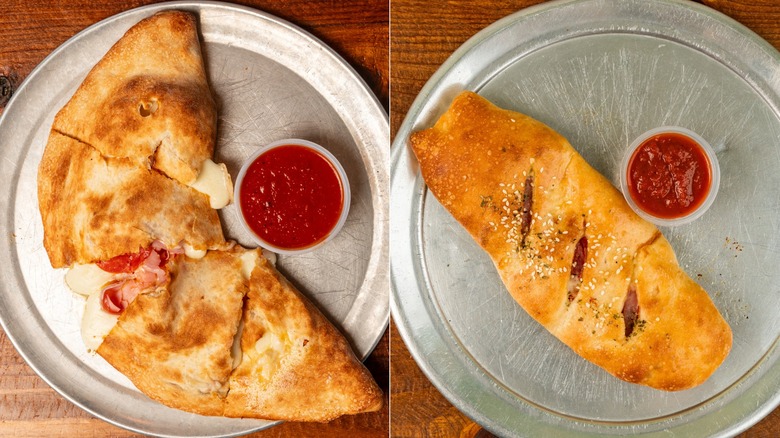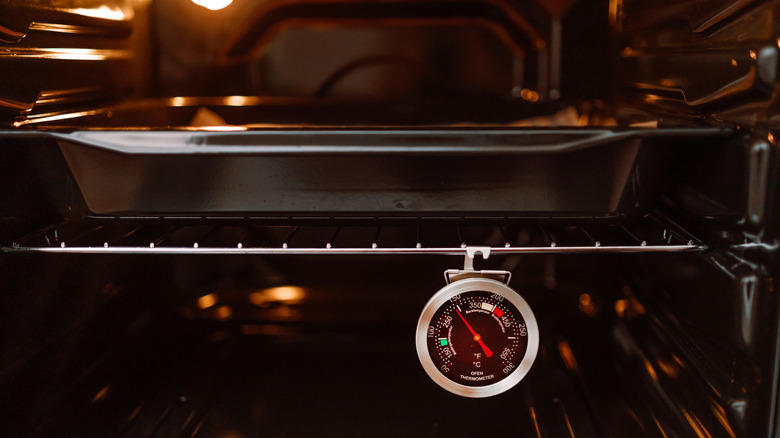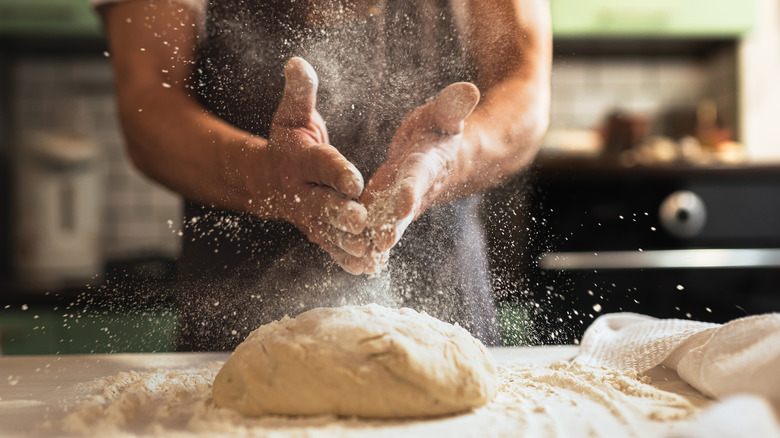
Eugene Gologursky/Getty Images
Few cuisines scratch the comfort food itch quite like Italian-American. It’s one of the most beloved styles of home-cooked food, especially for those who grew up in a ’90s American kitchen (I know I’m not the only one raised on pasta and hearty homemade sauces). But for many home cooks, Italian-American food stops at pasta.
Stromboli, on the other hand, is one of those iconic dishes that we grab as an afterthought with our pizza order, or snag on the fly to snack on in between the day’s tasks. However, as the third wave of Italian cuisine in the U.S. unfolds, homemade stromboli steps into the spotlight as more than just the stuff of our comfort food dreams.
I dished about stromboli with chef, restaurateur, and TV personality Scott Conant, whose knack for bringing authenticity to Italian-American classics has made him a household name. Conant’s latest restaurant venture, Leola — located in the beautiful Baha Mar Resort in the Bahamas — highlights the classic cuisine known for its cozy simplicity. At Leola, Conant gives dishes (including stromboli) his signature touch, making Italian-American food rustic yet refined. In our conversation, he shared his best advice for crafting a version that’s every bit as cozy as it is impressive, all from the comfort of your own kitchen.
Start by knowing what you’re making — stromboli vs. calzone

Baileystable/Getty & Hope Phillips/Shutterstock
Those who are just dipping their toes into the world of pizza-adjacent, stick-to-your-ribs food for the first time might be confused between two of the most popular dishes at their local pizzeria. A stromboli and a calzone share a lot of similarities, but once you dig a little deeper, you’ll find big differences between these two comfort food cousins.
A calzone is basically a folded pizza, where a pocket of pillowy dough is filled with meat, cheese, or veggie fillings. Stromboli, on the other hand, is layered with dough and similar fillings. Scott Conant explains that a calzone is made with pizza dough, while a stromboli is made with either bread dough or pizza dough. He goes deeper to explain the ingredient and preparation difference between calzones and stromboli: “[A] calzone is stuffed, folded, and then baked in the pizza oven, whereas stromboli is a little bit more like a bread. It’s stuffed and rolled, not folded…and then it’s baked in either a bread oven or a convection oven or whatever oven you have at home.”
Know the traditional fillings

Alleko/Getty Images
If you’re looking to whip up a stromboli that stays true to its roots, it’s important to get to know the traditional fillings. In true Italian-American fashion, authentic stromboli is simple, relying on the quality of the fillings to do most of the flavor-heavy lifting rather than lots of intricate ingredients to provide the wow factor.
Scott Conant explains that something as simple as cheese and sausage can make up the bulk of the stromboli filling. “The one that I love…is Genoa salami, smoked mozzarella, garlic, basil, and olive oil,” he says. “The basil really comes through…I put a lot of chopped raw garlic inside there, so that the raw garlic gets cooked and steamed in the interior of the bread as well… it has a great backdrop of flavor.”
A classic pepperoni stromboli with smoked or regular mozzarella, or even provolone, is easy to prepare and hard not to love. Salami and capicola make a homemade stromboli seem like it’s straight out of Manhattan’s Little Italy. Combined with mozzarella and something a little sharp, like Parmesan, it delivers in flavor and keeps the ingredients authentically Italian-American. When it comes to meats, the thinner the slices, the better. Thin slices of cured meats allow for easier layering in the dough, giving stromboli its signature texture.
The correct oven temperature is crucial

Irina Shatilova/Getty Images
Before you start gathering ingredients and preparing your homemade stromboli, get familiar with the proper baking procedure. One of the most common mistakes when baking, well, anything, comes down to the wrong oven temperature. It can lead to a soggy or burnt stromboli, or one that looks perfectly golden brown but yields sticky, undercooked dough in the middle.
Conant recommends baking your stromboli on a sheet pan at 375 degrees F to achieve a golden, flaky outer layer with a chewy — but thoroughly cooked — interior. He explains that it can be challenging to get the interior of the stromboli cooked properly due to its high moisture content. So keep an eye on your creation, especially when making stromboli for the first time. Conant bakes his in a convection oven and sometimes turns the temperature down to account for the convection fan’s heat circulation. He explains that the convection fan is great for an evenly-cooked stromboli.
Ovens can be inaccurate, sometimes by as much as 90 degrees, so employ a simple but crucial oven tip from Ina Garten if you have older equipment at home. Invest in an oven thermometer to protect your stromboli and other baked creations from falling victim to a faulty temperature reading.
Don’t neglect the dough

Larisa Stefanuyk/Getty Images
A well-executed dough is the cornerstone of an excellent homemade stromboli. Seemingly innocuous mistakes in dough preparation can make or break the dish, so be sure to get familiar with the correct technique before you start whipping up a from-scratch dough or rolling out a pre-made one that you purchased ahead of time. First, proper dough thickness is key to keeping stromboli’s structural integrity without making it too bread-heavy. “I always do mine about a half inch thick,” Conant says. “And then, of course, you have to proof it afterwards.” Be careful not to overproof the dough after it’s been rolled out, as this can alter the flavor and texture.
If you’re not interested in making a from-scratch dough for your homemade stromboli venture, you’re in luck. Bread dough or pizza dough can be used to make stromboli, and either can be purchased ahead of time. “I love the idea of going to your local pizzeria that you love and buying some extra dough from them and being able to make whatever you want from it,” says Conant. Whether you’re buying dough ahead of time or making your own, avoid a soggy stromboli by scoring it before it goes in the oven. This releases steam for a crispier crust.
Don’t be afraid to get creative

Daria Zelenska/Shutterstock
One of the most beautiful things about the humble stromboli is that it allows for almost infinite customization. A traditional stromboli is almost always stuffed with cured meats and cheeses, but you can still create a dish rooted in authenticity that’s completely outside the norm.
Conant describes the vegetarian stromboli that he makes: “We’d stuff it with broccoli rabe and some kind of delicious cheese, even if it’s just a grating of pecorino inside there with the broccoli rabe. Sauté that broccoli rabe with garlic and crushed red pepper, plenty of olive oil, and really cook it so it’s the way an Italian grandmother would cook it. It should be cooked all the way and limp with no texture to it, really. It’s just sheer bitter, garlicky, deliciousness.”
Conant goes on to encourage home cooks to have fun with southern Italian-inspired flavors by stuffing stromboli with all the commodities of an Italian-American kitchen. Stick with the basic structure so that your creation remains close to its roots, but have fun with flavors. He says he likes the idea of adding an egg to the filling to create a breakfast stromboli without compromising the dish’s structure, or even swapping out the traditional fillings, giving it a simple yet unique spin. Homemade stromboli thrives on spontaneity.
You don’t need to copy what you see at your local pizzeria
Chances are, the vast majority of your stromboli experiences came from your neighborhood pizzeria. There’s nothing wrong with a hearty stromboli from your favorite Italian-American place, but don’t compare your homemade creation to what you’ve always grabbed on the go.
“At a lot of the pizzerias, they kind of fall a little bit flat,” says Conant. “Maybe they make the dough a little bit too thin and it just doesn’t have the heft.” He explains that stromboli from pizzerias can be overstuffed, and while they still taste delicious, they’re often missing balance. “I like to think of [stromboli] as a bread. It’s a meat bread. It’s a chewy, meaty bread and I want the texture of that bread in the center and to see that spiral throughout,” he says. At a pizzeria, throwing the stromboli in the oven is kind of a thoughtless kitchen task, which can cause it to lose its intended shape and chewy, spiral-filled texture. In a home kitchen, you can put a lot more care and finesse into your dish.
Even though we all picture a pizzeria when we think of stromboli, it — and other classic Italian-American recipes — can be reinvented with a little care and creativity. At Leola, Conant treats stromboli as a staple, keeping it close to its rustic roots while giving it an artisanal spin that feels right at home in an elegant resort. It’s proof that modest Italian-American cuisine isn’t limited to old-fashioned simplicity.
Don’t worry if your first stromboli isn’t perfect

AliAfkham/Shutterstock
Like most good things in the kitchen, stromboli takes a little practice and a little forgiveness. Even Scott Conant, who’s spent decades perfecting Italian-inspired recipes, says it’s not about chasing perfection. “I think it’s a lot of patience and a lot of practice,” he says. “But most importantly, it’s about just making what you love most.”
As an avid baker and home cook, I know it’s tricky to get a new recipe right on the first attempt. This will likely be the case when making your first stromboli. Whether you overstuffed it, baked it too long, overproofed the dough, or added ingredients with disjointed flavor profiles, there are a lot of easy mistakes to make with this recipe. Jot down what went wrong and learn from your mistake for next time, until your dish is exactly how you want it.
Once you learn how to roll and proof the dough correctly and layer the fillings so there’s balance, then you can start experimenting. Learn to make something like a cheesesteak stromboli or breakfast stromboli once you have the basic method down pat. Conant encourages home cooks to have fun with this dish: “What are the flavor profiles that you love? Stuff it with that.”


Dining and Cooking